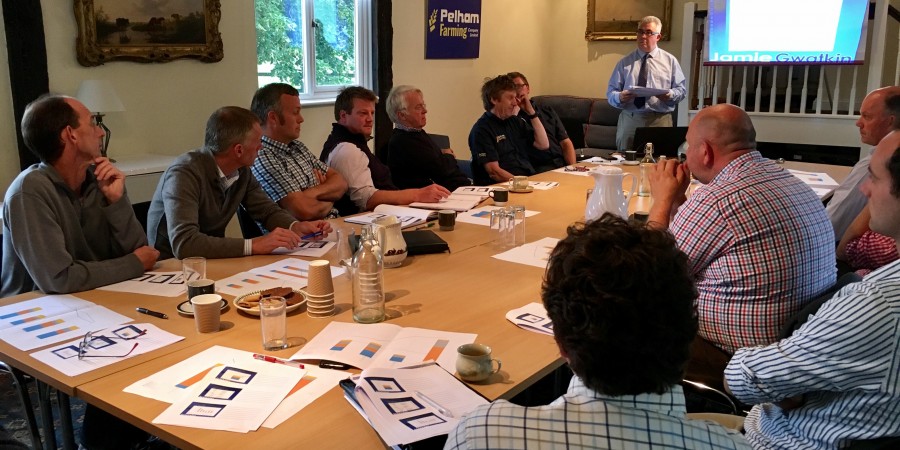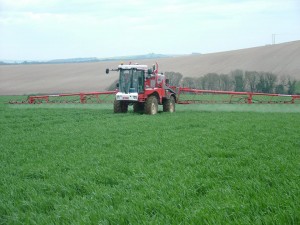With rain pouring down across the rolling landscape of East Hertfordshire, it was the perfect weather for representatives of ten JVFG member businesses to take time away from the farm for some business analysis. The main theme for the JVFG summer meeting, hosted by Pelham Farming, was sprayer analysis.The spotlight shone on benchmarking sprayer performance across the group.
Paying ways for sprayer days
At the outset it was revealed that the trend in JVFG average spray application costs has continued downwards from £5.30/ha (2014) to £4.62/ha (2017 to date). But everyone around the table wanted to know their own results compared to that.

JVFG consultant Jamie Gwatkin continues to be impressed by joint ventures driving down costs of spraying.
Business by business, JVFG consultant Jamie Gwatkin shared how far above, or below, the JVFG benchmarked standard each machinery choice is performing. “It’s interesting how with more joint ventures coming into JVFG they are bringing with them new combinations of equipment – whether trailed sprayers or self-propelled and applying just sprays or liquid fertilisers as well – for us to compare and contrast.”
These individual results were followed, as is always the case, by really useful discussion about the differences that choice of machine, style of management and skill of operator make.
Never mind tank size or boom width – where’s the water?
The businesses achieving the highest sprayer work rates – whether self-propelled or trailed – put their impressive hectarage covered down to one thing: water supply. Ollie Stratford, who oversees the E.C. Drummond’s arable operation in Hampshire, explained how they have got the most from the Massey 7720 pulling a Horsch Leeb. “This year we’ve focussed on having a bowser field side, always ready for fill up, to reduce the stop time and keep the coverage going. The sprayer and the bowser go as a pair. The bowser operator has a very important job. He knows the task, the materials needed and is there with the water in his 12000 litre bowser. Everything is on hand on time to keep output up.” Their result is impressive: almost 16000 hectares sprayer work this year applying liquid fertiliser as well as spraying.
From Cambridgeshire, James Thorpe, managing for A.G.Wright Farms, added that he always allocates bowser support for the Agrifac Condor 17. “It’s a 1.5 man and machine job these days. That, and having a fast fold boom, which shuts in just 11 seconds, means we are achieving a work rate of 7.38 ha/hr.” With a high proportion of root crops in his system that slows the kit performance beneath the benchmark average of 9.15ha/hr.
Smooth operators do more than spray
With many of the JVFG member businesses having a dedicated man for the task all year round, the difference made by the professionalism of the sprayer operator comes to the fore. Tim Merry, managing for JV Farming in Dorset, pointed out that a recent change of operator has improved results significantly and per hectare costs are heading sharply downwards towards the benchmarked target figure. “Despite having on average quite small size fields in 13 blocks over a 22 mile radius, and not always with convenient fill up, my new operator has produced very good work and the impact is plain to see in these costs.”
Pick a sprayer that pays back
Most JVFG members have their machinery on five year replacement programme. So with many about to re-invest there were many minds in the room wondering how they will choose their next machine. “Is there a machine that stands out from the rest?” asked Jamie Gwatkin.
The consensus from the group was “no”. Reviewing the last three sets of sprayer rankings Batemans – RB 25 or RB 35 – had dominated the field in 2015 with costs in the region of £2.65-4.70/ha. However in 2017 the Bateman brand has been nudged aside with a Horsch Leeb Trail and the Agrifac Condor joining it on the productivity podium with costs of operation of £2.91-3.17/ha.
“What’s best is to have the right machine for what you are doing.”, advises Jamie Gwatkin.”There is a lot of choice out there. But whether your change of sprayer is voluntary and part of your policy of renewal or forced we have the evidence that measures performance in a range of situations. I am impressed how some JVFG members are getting huge output of their machinery and have reduced their costs.”


